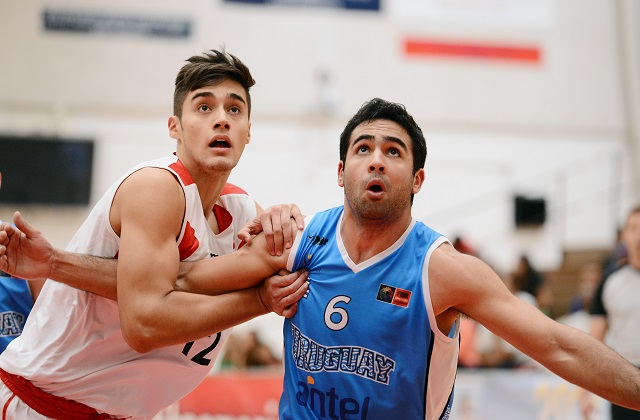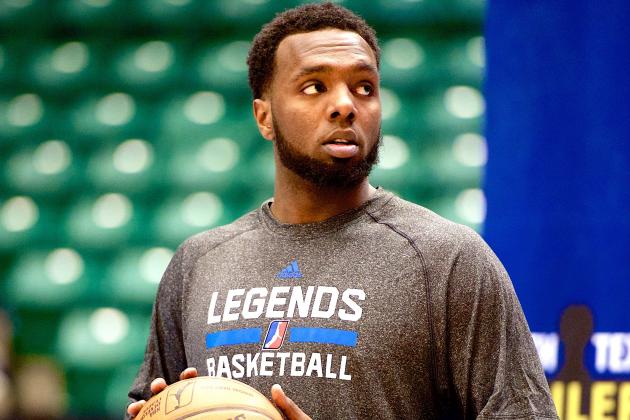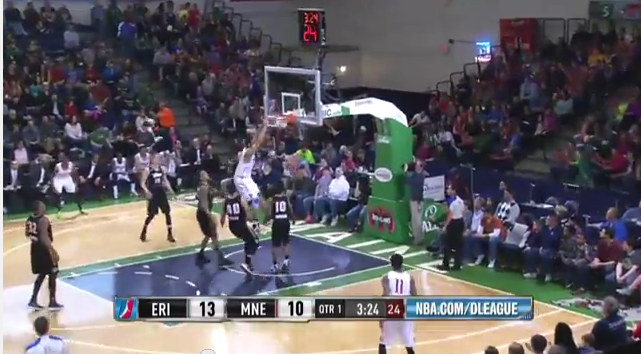In this post, MLH is going to highlight all the players who played foreign ball last season that are participating in the Orlando Summer League. A lot of players we have mentioned already, but we'll list them again just for continuity sake.
Note: Stats are according to Eurobasket database.
List of All Summer League Players Who Played International Professional Ball last season.
Boston Celtics
- Dairis Bertans, G, 6'4, 183 pounds. Team: Bilbao Basket (Spain). Stats: 10.3 ppg, 1.6 rpg, 1.1 apg.
- Edwin Jackson, G, 6'3, 201 pounds. Team: ASVEL (France). Stats: 18 ppg, 3.5 rpg, 2.3 apg.
Brooklyn Nets
- Daniel Clark, F/C, 6'11, 210 pounds. Team: Laboral Kutxa Vitora (Spain). Stats: Only played 1 game.
- Donte Greene, F, 6'9, 226 pounds. Team: Dongguan Leopards (China). Stats: 19.6 ppg, 7.8 rpg, 1.3 bpg.
- Nick Minnerath, F, 6'9, 215 pounds. Team: STB Le Havre (France). Stats: 11.9 ppg, 2.1 rpg, 1.0 apg.
- Alen Omic, C, 7'1, 225 pounds. Team: Union Olimpija Ljubljana (Slovenia). Stats: 10.2 ppg, 6.4 rpg, 1.1 bpg.
- DaJuan Summers, F, 6'8, 240 pounds. Team: Budivelnyk Kyiv (Ukraine). Stats: 15.3 ppg, 7.8 rpg, 1.4 apg.
Houston Rockets
- Miro Bilan, C, 6'11, 245 pounds. Team: KK Cedevita Zagreb (Croatia). Stats: 13.3ppg, 6.4 rpg, 1.5 apg.
Indiana Pacers
- Kevin Jones, F, 6'8, 251 pounds. Team: San Miguel Beermen (Philippines). Stats: Has not played yet this year for San Miguel.
Memphis Grizzlies
- Janis Timma, F/G, 6'7, 226 pounds. Team: BK Ventspils (Latvia). Stats: 12.7 ppg, 6.3 rpg, 3.5 apg.
- Jack Cooley, F/C, 6'9, 244 pounds. Team: Trabzonspor (Turkey). Stats: 12.5 ppg, 6.8 rpg.
- Jarrid Famous, C, 6'11, 240 pounds. Team: Tadamon Zouk (Lebanon). Stats: 19.5 ppg, 9.7 rpg, 1.6 bpg.
- Deon Thompson, F, 6'8, 250 pounds. Team: Bayern Munich (Germany). Stats: 11.5 ppg, 5.3 rpg.
- Edwin Ubiles, G/F, 6'6, 204 pounds. Team: Kyoto Hannaryz (Japan). Stats: 15.5 ppg, 3.8 rpg, 2.2 apg.
- Terrico White, G, 6'5, 215 pounds. Team: Hapoel Eilat (Israel). Stats: 14.1 ppg, 3.9 rpg, 1.1 spg.
Miami Heat
- Ivan Aska, F, 6'7, 230 pounds. Team(s): Ikaros Kallitheas (Greece) and Cangrejeros de Santurce (Puerto Rico). Stats: 15.2 ppg, 7 rpg (25 games for Ikaors); 6.9 ppg, 4.5 rpg (11 games for CDS).
- Danilo Barthel, 6'10, 220 pounds. Team: Fraport Skyliners Frankfurt (Germany). Stats: 11.3 ppg, 4.9 rpg, 1.4 apg.
- Nobel Boungou Colo, 6'8, 215 pounds. Team: Limoges CSP Elite (France). Stats: 15 ppg, 5.1 rpg, 1.8 apg.
Orlando Magic
- Kim English, G, 6'6, 200 pounds. Team: Chorale de Roanne (France). Stats: 11.2 ppg, 2.4 rpg, 1.9 apg.
- Vernon Macklin, F, 6'10, 227 pounds. Team: Liaoning Jiebao Hunters (China). Stats: 12.9 ppg, 5.7 rpg.
Philadelphia 76ers
- Casper Ware, G, 5'10, 175 pounds. Team: Granarolo de Bologna (Italy). Stats: 11.7 ppg, 2.7 rpg, 2.2 apg.
Teams without foreign representation: Detroit Pistons, Oklahoma City Thunder.
Now that all of the players with foreign professional experience last year have been listed, let's take a look at the Top-5 players from the list compiled above. This is my own personal rankings, and I give explanation of why I rated them so and give an outlook on their potential below the video.
MLH Top-5 European League Players in Summer League.
1. Terrico White, Memphis
A strong athlete and scorer, White is a veteran of many foreign leagues, playing in Israel, Turkey Serbia and even here in the states in the D-League (Idaho) and NBA (Pistons). At 6'5, White is a strong combo guard with good inside-outside ability. He reminds a lot of people of a poor man's Rodney Stuckey, and he can go off for scoring at will, as evidenced by the highlight tape above when he was playing in Serbia for Radnicki KG. The Grizzlies need help on the perimeter, and White is a dark horse to make an impact thanks to his experience and growth as a player overseas.
2. Edwin Jackson, Boston Celtics
The Celtics need more perimeter scoring and Jackson looks like he could be the under the radar player to do it. While I mentioned him in an earlier post, I can't stop gushing about the Frenchman. While more of a combo guard, he displays a beautiful shot, excellent jumping ability and a strong knack to playing above the rim. He offers instant offense and athleticism to this Celtics summer league squad. A player who is a bit older (he's 25) and spent most of his development in France (he hasn't played professionally outside the country), Jackson will be tested in this exposure to American professional basketball, but he appears polished with just enough upside to really stand out in Orlando.
3. Janis Timma, Memphis Grizzlies
The Grizzlies' 2013 2nd round pick, Timma spent the year back in Latvia developing his game. Timma, though not wowing in terms of athleticism, the 6'7 forward brings a balanced game with a strong overall skill set. He can score, rebound, handle the ball and create for others on the offensive end. His game is the equivalent of a "Swiss Army Knife" and he shows extraordinary polish for a player who is only 22 years old. There is no timetable in terms of when Timma will make his way permanently stateside for the Grizzlies, but with a strong Summer League campaign, he may force Grizzly management to bring him over sooner rather than later.
4. Donte Greene, Brooklyn Nets
Who knows how much Greene has left in the tank. A tall wing/forward combo who has always had promise and potential, Greene hasn't really fulfilled expectations in the NBA, whether its fans or his own. He looked on the cusp of a breakout with Sacramento, but inconsistent performance and playing time ended up leading to his ouster, and he's been traveling around ever since, jumping from D-League squads, to teams in Puerto Rico to even the Chinese Basketball Association. However, averaging near 20-8 in China for DongGuan (who finished 3rd in League) certainly helped his case this past season. Only 26, this latest Summer League may be a chance for Greene to prove that he can help a NBA team off the bench as a tall, aggressive energy guy.
5. Deon Thompson, Memphis Grizzlies
A star out of North Carolina, Thompson has endured a tough professional career, playing in Greece, Slovenia and Germany since graduating from UNC. Thompson though, while not flashy, may be one of the most polished players on this list. While his numbers are meager, Thompson without a doubt played against the toughest European competition while suiting up for Bayern Munich. Furthermore, Thompson's maturity and professionalism strike you as a plus in his favor, especially when you watch this interview. If Thompson is going to make a NBA squad this summer, he's not going to make one based on potential or upside. He'll make it because of his intangibles, polish and ability to play on a team, as he did the past season for Bayern Munich.



















.png)



